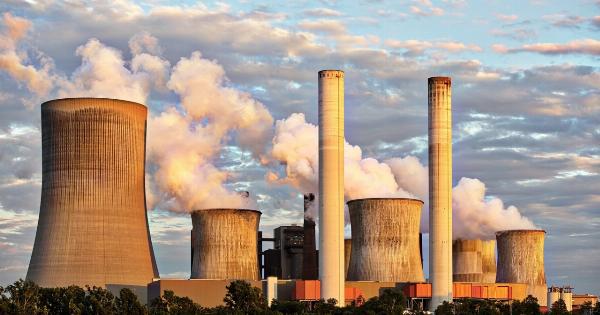Lung cancer is a devastating disease that affects millions of people worldwide. It is commonly associated with smoking, but there are other lesser-known factors that can increase your risk of developing this deadly condition.
In this article, we will explore some of these lesser-known risk factors and how you can reduce your risk.
1. Exposure to Radon Gas
Radon is a radioactive gas that occurs naturally in the environment. It can seep into buildings from the ground and become trapped, leading to elevated levels of radon gas indoors.
Prolonged exposure to high levels of radon gas has been linked to an increased risk of lung cancer. Testing your home for radon and taking steps to reduce its levels can help lower your risk.
2. Secondhand Smoke
While the association between smoking and lung cancer is well-known, exposure to secondhand smoke can also increase your risk.
Breathing in the smoke exhaled by smokers or the smoke from burning tobacco products can expose you to carcinogens and other toxic chemicals. Avoiding environments where smoking is allowed and encouraging smokers to quit can help reduce your risk.
3. Air Pollution
Poor air quality can have a significant impact on your respiratory health. Long-term exposure to air pollution, especially fine particulate matter, has been linked to an increased risk of lung cancer.
Living in areas with high levels of air pollution or working in environments with exposure to harmful pollutants can raise your risk. Taking steps to minimize exposure, such as wearing masks and avoiding heavily polluted areas, can be beneficial.
4. Occupational Hazards
Some occupations involve exposure to hazardous substances that can increase the risk of lung cancer. Asbestos, silica, diesel exhaust, and certain chemicals used in industries like mining, construction, and manufacturing have been linked to lung cancer.
If you work in a high-risk occupation, following safety protocols, wearing protective equipment, and minimizing exposure can help protect your lung health.
5. Family History and Genetics
A family history of lung cancer can increase your risk, suggesting the involvement of genetic factors. Although most cases of lung cancer are not directly inherited, certain genetic variations can make individuals more susceptible to the disease.
If you have a family history of lung cancer, it is important to discuss it with your healthcare provider to determine if additional screening or preventive measures are necessary.
6. Personal History of Lung Disease
If you have a history of lung diseases such as chronic obstructive pulmonary disease (COPD) or tuberculosis, your risk of developing lung cancer may be higher.
These conditions can cause damage to the lungs, making them more vulnerable to the development of cancer. Maintaining good lung health, quitting smoking, and receiving appropriate medical treatment for respiratory conditions can help reduce your risk.
7. Diet and Nutritional Factors
While diet alone may not directly cause lung cancer, certain dietary factors can contribute to an increased risk.
A diet low in fruits and vegetables, which are rich in antioxidants and other beneficial compounds, may increase your susceptibility to lung cancer. On the other hand, a healthy diet rich in nutrient-dense foods can help protect against various diseases, including lung cancer.
8. Hormonal Factors
Research suggests that hormones may play a role in lung cancer development, particularly in women. Estrogen, for example, has been found to promote the growth of lung cancer cells.
Hormonal changes during pregnancy, menopause, or the use of hormone replacement therapy may impact lung cancer risk. Further studies are needed to better understand the relationship between hormones and lung cancer.
9. Chronic Inflammation
Chronic inflammation in the lungs can increase the risk of developing lung cancer. Conditions such as chronic bronchitis and pneumonia can lead to persistent inflammation in the respiratory system, potentially promoting the growth of cancer cells.
Managing and treating chronic inflammation promptly can be crucial in reducing lung cancer risk.
10. Age and Gender
Advancing age is a significant risk factor for lung cancer, with the majority of cases occurring in individuals over 65 years old. Additionally, men tend to have a higher risk of developing lung cancer compared to women.
These demographic factors should be taken into account when considering preventive measures and screening for lung cancer.
Reducing Your Risk
While some risk factors for lung cancer cannot be changed, such as age and genetic factors, there are steps you can take to reduce your overall risk:.
1. Quit smoking and avoid exposure to secondhand smoke.
2. Test your home for radon gas and take appropriate measures to reduce exposure if necessary.
3. Minimize your exposure to air pollution by staying indoors on high-pollution days and using air purifiers.
4. Follow safety protocols and use protective equipment if you work in a high-risk occupation.
5. Adopt a healthy diet rich in fruits, vegetables, and whole grains to support overall health.
6. Manage and treat lung diseases promptly to prevent further damage and potential development of cancer.
7. Stay updated on recommended cancer screenings and discuss your individual risk factors with your healthcare provider.
By understanding these lesser-known risk factors and taking proactive steps to reduce your risk, you can protect your lung health and potentially prevent the development of lung cancer.





























